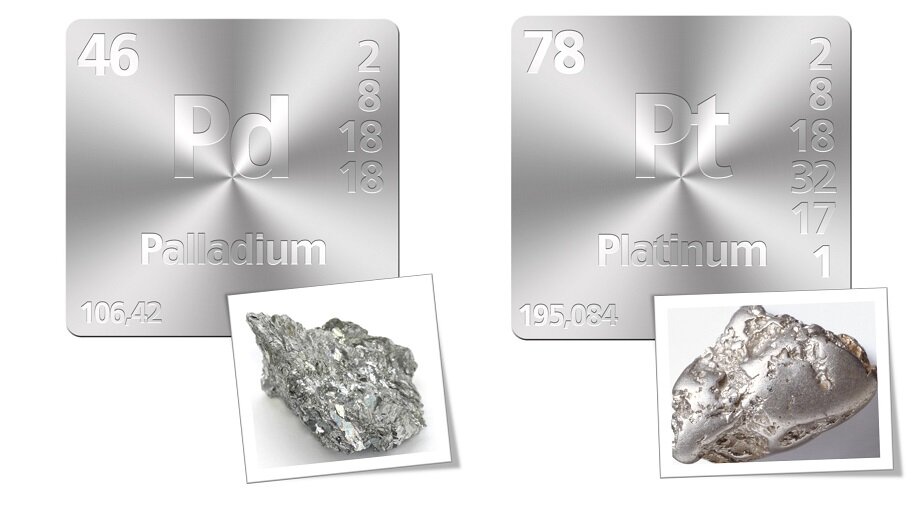On Metals, part 1: Platinum v. Palladium
 “Smith” - verb, gerund or present participle: smithing 1. treat (metal) by heating, hammering, and forging it.Such a simple term, right? You’ve heard it before, most likely in a reference to that old-timey blacksmith you can watch at Mount Vernon. At Alexandria & Company, we are smiths at our core. We specialize in metalsmithing, specifically as it pertains to silver, gold, and platinum. We work with other metals as well, but our specialty is definitely in the precious metals realm. Our goldsmith, Ricardo, is a third-generation goldsmith who understands gold and platinum like it’s in his blood. Lawrence, our silversmith, has been working with sterling silver since he was 16 and will wax poetic on its amazing properties. And trust me, don’t ask Tim about the elemental composition of a metal unless you are comfortably seated and satiated. It could take a while.Choosing the metal for your custom ring is one of the most foundational decisions you’ll make in the process. Each option has its own benefits and drawbacks and when we work with our clients we take the time to go through those in detail. But -- lucky you, Stylebook reader -- I’ve put together a series of Beginner’s Guides to Metals that I hope will prove both interesting and informative, and perhaps even shake off some of the seemingly intimidating aspects of jewelry design. It’s like a science series for jewelry! Read on for part one: Platinum v. Palladium.
“Smith” - verb, gerund or present participle: smithing 1. treat (metal) by heating, hammering, and forging it.Such a simple term, right? You’ve heard it before, most likely in a reference to that old-timey blacksmith you can watch at Mount Vernon. At Alexandria & Company, we are smiths at our core. We specialize in metalsmithing, specifically as it pertains to silver, gold, and platinum. We work with other metals as well, but our specialty is definitely in the precious metals realm. Our goldsmith, Ricardo, is a third-generation goldsmith who understands gold and platinum like it’s in his blood. Lawrence, our silversmith, has been working with sterling silver since he was 16 and will wax poetic on its amazing properties. And trust me, don’t ask Tim about the elemental composition of a metal unless you are comfortably seated and satiated. It could take a while.Choosing the metal for your custom ring is one of the most foundational decisions you’ll make in the process. Each option has its own benefits and drawbacks and when we work with our clients we take the time to go through those in detail. But -- lucky you, Stylebook reader -- I’ve put together a series of Beginner’s Guides to Metals that I hope will prove both interesting and informative, and perhaps even shake off some of the seemingly intimidating aspects of jewelry design. It’s like a science series for jewelry! Read on for part one: Platinum v. Palladium. If you remember your 8th grade chemistry class and that big Periodic Table of Elements your teacher probably had behind his or her desk, you may recall the “Noble Metals,” those special elements which are extremely resistant to tarnishing and corrosion. Platinum and palladium, along with other metals such as gold and silver, are noble metals. As they are both rare elements and difficult to mine, they are relatively expensive. Both elements are used for industrial purposes as they are extremely strong, have high melting points, and are excellent catalysts (substances that speed up chemical reactions). As such, both platinum and palladium are used in things such as catalytic converters (in fact, nearly half of the platinum mined each year is used in these). Interestingly, platinum is increasingly used in cancer treatments and you’ll also find it in pacemakers, dental materials, and other medical uses. Due to their wide variety of uses, platinum and palladium prices are therefore subject to a high degree of volatility dependent upon market conditions, political turbulence, and global industrial demand.Platinum and palladium are compositionally and aesthetically similar, but they differ in significant detail, especially with regard to their utility in jewelry making. Platinum is in many ways an ideal metal for engagement-style settings because it’s amazingly strong (perfect to hold those precious stones) and the “white” color of the metal is inherent to its composition, so it will never fade. Its strength is derived from the density of its composition, so you’ll find that platinum jewelry often feels weightier than other metals. More importantly, though, platinum is also very malleable and ductile, so it’s relatively easy to shape and stretch into wire for jewelry making. It’s also one of the transition metals on the Periodic Table (along with gold, silver, copper, and titanium), which means they can bond easily with other elements. You can therefore use platinum in mixed-metal pieces much more successfully than you can use palladium.Platinum, though, can present its own challenges. Some jewelers don’t work with the metal because it holds an extremely high melting point and requires special tools and experience to work with it (FYI, we do work with platinum). So, sizing a ring will likely be more expensive in platinum than in other metals, not just for the material, but for the complexity of the work. Platinum is also usually significantly more expensive than other options.
If you remember your 8th grade chemistry class and that big Periodic Table of Elements your teacher probably had behind his or her desk, you may recall the “Noble Metals,” those special elements which are extremely resistant to tarnishing and corrosion. Platinum and palladium, along with other metals such as gold and silver, are noble metals. As they are both rare elements and difficult to mine, they are relatively expensive. Both elements are used for industrial purposes as they are extremely strong, have high melting points, and are excellent catalysts (substances that speed up chemical reactions). As such, both platinum and palladium are used in things such as catalytic converters (in fact, nearly half of the platinum mined each year is used in these). Interestingly, platinum is increasingly used in cancer treatments and you’ll also find it in pacemakers, dental materials, and other medical uses. Due to their wide variety of uses, platinum and palladium prices are therefore subject to a high degree of volatility dependent upon market conditions, political turbulence, and global industrial demand.Platinum and palladium are compositionally and aesthetically similar, but they differ in significant detail, especially with regard to their utility in jewelry making. Platinum is in many ways an ideal metal for engagement-style settings because it’s amazingly strong (perfect to hold those precious stones) and the “white” color of the metal is inherent to its composition, so it will never fade. Its strength is derived from the density of its composition, so you’ll find that platinum jewelry often feels weightier than other metals. More importantly, though, platinum is also very malleable and ductile, so it’s relatively easy to shape and stretch into wire for jewelry making. It’s also one of the transition metals on the Periodic Table (along with gold, silver, copper, and titanium), which means they can bond easily with other elements. You can therefore use platinum in mixed-metal pieces much more successfully than you can use palladium.Platinum, though, can present its own challenges. Some jewelers don’t work with the metal because it holds an extremely high melting point and requires special tools and experience to work with it (FYI, we do work with platinum). So, sizing a ring will likely be more expensive in platinum than in other metals, not just for the material, but for the complexity of the work. Platinum is also usually significantly more expensive than other options.
Both rings feature a yellow sapphire and diamonds. The left ring is made out of palladium, which worked well for this setting since it didn’t have lots of diamonds on the sides or intricate detailing. The ring on the right is made out of platinum.
An alternative to platinum that we offer is palladium, which is similarly durable and also inherently “white,” like platinum. Historically, palladium has been used as an industrial metal much more commonly than in jewelry but its popularity is definitely growing as a sound alternative to platinum. It’s a great option for wedding bands because you get the maintenance-free aspect of the “white” metal at (usually) a lower price than platinum. One drawback of palladium is that it doesn’t cast delicate designs well, so we usually don’t recommend creating a traditional engagement-style ring in palladium. While bands are great, prongs and filigree just don’t work well in the metal.Another interesting point about palladium is that because it’s an industrial metal that is only mined in a few regions, every once in a while the trade price for the metal shoots up and it becomes more expensive than platinum. A recent example that we felt directly was in 2014, when political instability in Russia (the chief producer of palladium) caused the price to skyrocket. We found ourselves recommending platinum over palladium for budget-friendly wedding bands, which was an odd time for the jewelry industry!There’s much to be learned about these amazing metals and how we use them in our daily lives. Next in the series, we’ll visit that most intriguing and poetic of elements… gold! Stay tuned...


